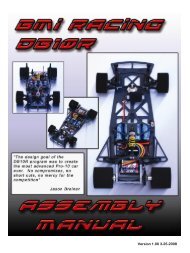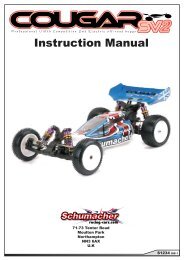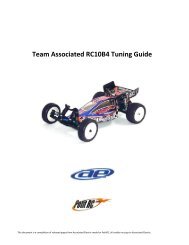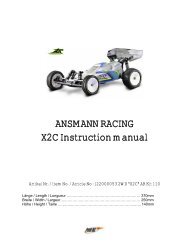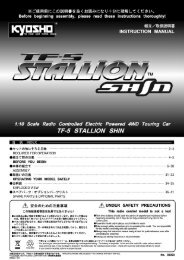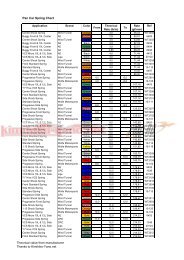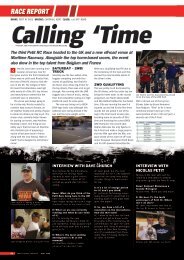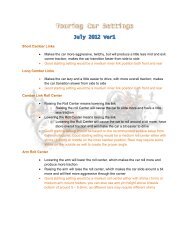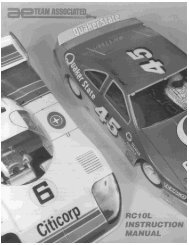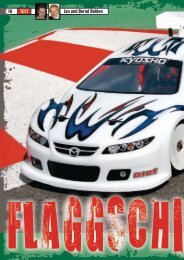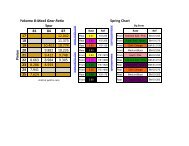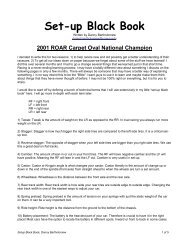Kinwald Edition XXX - Team Losi Racing
Kinwald Edition XXX - Team Losi Racing
Kinwald Edition XXX - Team Losi Racing
Create successful ePaper yourself
Turn your PDF publications into a flip-book with our unique Google optimized e-Paper software.
that the slipper will slip before the diff.<br />
Adjusting the Slippershould be done after the diff is properly adjusted. If you have just finished adjusting the<br />
differential, loosen the slipper adjustment nut four full turns (e.g., 360 degrees x 4) to return the adjustment to the setting<br />
originally described in the assembly instructions. To make the final adjustments, place your car on the racing surface and<br />
give the car full throttle. The slipper should slip for one or two feet at the most. If the slipper slips for more than two feet,<br />
you’ll need to tighten the adjustment nut. If the slipper doesn’t slip for at least one foot, back off the adjustment nut 1/8<br />
of a turn and retry. If you can’t hear the slipper when you punch the throttle, hold the front of the car with the rear wheels<br />
still on the track and give the car full throttle. The car should push against your hand with reasonable force and the<br />
slipper only slipping slightly. Don't expect the slipper to make up for poor driving or set-up. You still have to use the<br />
throttle and maintain the shocks and chassis. The slipper will help you drive more comfortably and help accelerate of<br />
corners and land jumps.<br />
When the track is really rough, rutty, or has a lot of killer jumps, you may want to consider installing a Hydra-Drive<br />
unit. When using the Hydra-Drive, the slipper adjustment should be set a bit looser so that the spur gear is easier to<br />
rotate while holding the right rear tire. Use the same method of checking adjustment on the Hydra-Drive as you would<br />
on the standard friction slipper. Do not run the Hydra-Drive too loose; it will build up heat and eventually damage the<br />
seals. The standard fluid should be used most of the time in the Hydra-Drive. This kit has a different type of slipper that<br />
cannot be used with the Hydra-Drive as it is currently assembled. However, a Hydra-Drive unit can be fit to the shaft by<br />
replacing the gear and outside aluminum slipper back plate with the Hydra-Drive spur gear, gear plate, Hydra-Drive<br />
unit, spring, etc. A Hydra-Drive conversion kit is also available (part #A3112).<br />
The Most Sensitive Adjustments, and the most used by the <strong>Team</strong> <strong>Losi</strong> race team, are the number of washers<br />
under the front camber link ball studs and the anti-squat. See these two sections and try to familiarize yourself with the<br />
way that these adjustments affect the handling of the Triple-X.<br />
Ride Height is an adjustment that affects the way your car jumps, turns, and goes through bumps. To check the ride<br />
height, drop one end (front or rear) of the car from about a 5-6 inch height onto a flat surface. Once the car settles in to<br />
a position, check the height of that end of the car in relationship to the surface. To raise the ride height, lower the shock<br />
adjuster nuts on the shocks evenly on the end (front or rear) of the car you are working on. To lower the ride height, raise<br />
the shock adjuster nuts. Both left and right nuts should be adjusted evenly.<br />
You should start with the front ride height set so that the front suspension arms are level with the surface. Occasionally,<br />
you may want to raise the front ride height to get a little quicker steering reaction, but be careful as this can also<br />
make the car flip over more easily. The rear ride height should be set so that the car comes to a rest at a height that is<br />
right in between having the arms level and the dogbones level with the surface. Every driver likes a little different feel so<br />
you should try small ride height adjustments to obtain the feel you like. We have found that ride height is really a minor<br />
adjustment. This should be one of the last adjustments after everything else has been dialed in. Do not use ride height<br />
adjustment as a substitute for a spring rate. If your car needs a softer or firmer spring, change the spring. Do not think<br />
that simply moving the shock nuts will change the stiffness of the spring; it won’t!<br />
Rear Hub Camber Location is best set according the settings described in this manual. You should start with the<br />
outer hole in the hub. The outer hole will tend to make the car feel a bit stiffer. This results in the car accelerating<br />
straighter and also makes it a bit eassier to line up for jumps. Moving to the inner hole will typically make the car go<br />
through bumps better. The inner hole may also give the feeling of more steering. This steering generally comes from the<br />
rear end though. What this means is that the rear end of the car may swing a bit more — at times even sliding more.<br />
Rear Camber Link Length can be another useful adjustment. It is virtually impossible to make a blanket statement<br />
for exactly how the length of the camber link will affect the handling under all conditions. The following is our experience<br />
with how the length of the camber link will typically affect the handling of the Triple-X. A longer rear camber link<br />
will usually result in more rear traction. With a longer link, the car can start to drive more square, or point-to-point. This<br />
can make it difficult to carve corners at high speed. A shorter rear camber link will generally result in more steering from<br />
the rear of the car due to increased chassis roll. This can make it easier to change directions quicker, but can cause the<br />
rear of the car to roll around if the link is too short. A shorter rear link will usually go through bumps a bit better than a<br />
long link as well.<br />
32



